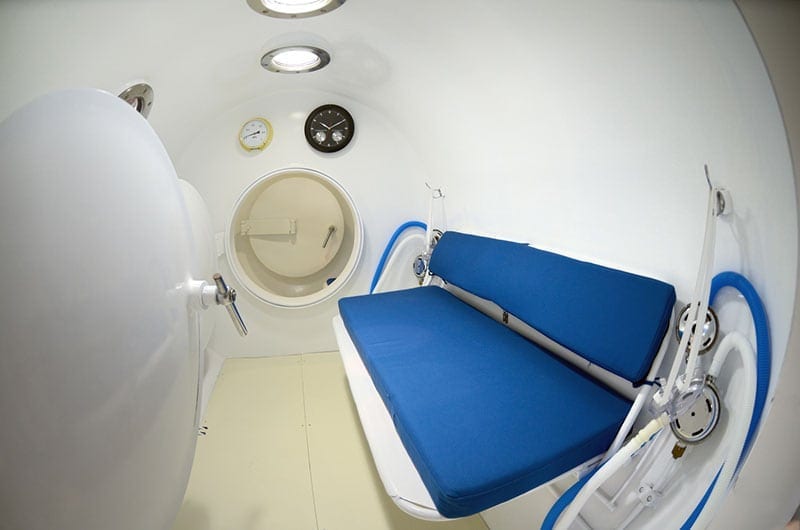Hyperbaric oxygen therapy was originally used as a scuba diver treatment relating to decompression sickness but now is used to treat multiple conditions including diabetic wounds. It can also be used to treat burns and flesh eating wounds caused by bacteria. It is often promoted as an effective treatment for diabetic foot wounds and other potentially harmful conditions such as bone infections and soft tissue injuries relating to diabetes. People with diabetes need to carefully treat wounds to avoid health complications. Discover more about diabetes wound care and hyperbaric oxygen therapy (HBOT).
What is Hyperbaric Oxygen Therapy?
According to Dr. Juan Bravo, an expert in hyperbaric oxygen therapy at Broward Health in South Florida, “Hypoxia is an insufficient amount of oxygen and can prevent normal wound healing”. Prior to this advanced therapy, many people with diabetes who had open wounds on their limbs often needed amputation due to poor healing. Hyperbaric oxygen therapy is a way to expose your body to 100 percent oxygen at a higher pressure than normal. Oxygen is essential to properly heal wounds. By exposing the wound to high levels of oxygen, the healing process can be quicker in many cases. There are specific criteria for each patient prior to receiving HBOT. The therapy is administered inside a chamber that allows the patient to breathe 100 percent oxygen which is 3 times more than a person gets in regular air. The intensive oxygen supply helps with wound healing. The patient is put on a stretcher and slipped into the chamber or closed tube. The feeling of pressure resembles that of “being on an airplane”. Patients are allowed to read, listen to music or watch TV when available. Most times, treatments require from 10-60 sessions. It is an outpatient procedure that does not cause pain or require pre-procedure medication which could have prevented them from driving afterwards. A cotton gown is worn inside the tube or chamber instead of street clothes which may catch on fire.
Why is Wound Care Essential for People with Diabetes?
People with diabetes have a compromised immune system which means they are more prone to infections and other complications when they have a wound. It can take weeks, or even months, for a wound to properly heal when you have diabetes. It is important for people with diabetes to treat wounds immediately. Keep plenty of wound care supplies on-hand to care for your wound after you learn how they need to be applied. Proper foot care is also essential to avoid foot ulcers and wounds that can come from cuts, sores, blisters, calluses and other food injuries. Never try to cut or scrape calluses. Gently use a pumice stone to file them down or see a podiatrist for care. Wash your feet daily with mild soap, lukewarm water, and dry them with a soft, absorbent towel. Pat your feet dry rather than rubbing them. Apply moisturizer to your feet after washing them, making sure to avoid the areas between the toes. If you have trouble seeing your feet use a mirror. If you have difficulties reaching them consider a professional pedicure at a medical office. Wear shoes that fit properly. Have your feet measured and always wear comfortable, supportive footwear. Stay away from high heels, open-toed shoes, and flip-flops. Avoid going barefoot. Wear sturdy slippers at home and water shoes at the beach or pool.
How Do You Treat a Foot Wound or Other Wound With Diabetes?
People with diabetes must treat the most minor wounds or sores quickly to avoid possible complications. These wounds can be even more complex when they occur on the feet or legs due to circulation and nerve damage. Some people with diabetes have neuropathy that makes it impossible to feel these wounds or leg sores. Examine your feet every day for sores or other irregularities. All types of wounds, even minor ones, should get medical treatment when you have diabetes. A medical professional knows the proper way to treat and care for any wound. After the doctor treats your wound a cream may be prescribed for you to use when you get home. The wound may also require bandages. If you have a painful open wound on your foot, the doctor may give you a cast or boot to wear and advise you to stay off the foot for a few days. In some situations, hyperbaric oxygen therapy might be recommended to boost the healing process.
What are other options for HBOT?
There are various ways to administer hyperbaric oxygen therapy besides the tube or chamber. Often topical HBOT is used for people with diabetes who have small contained foot ulcers or wounds. The therapy is applied to just that one part of the body. This may be done by wrapping your foot or leg in a plastic bag that is filled with 100 percent oxygen that is under pressure. This is a simpler procedure to perform and typically costs less than other types of HBOT.
In What Types of Situations Can Hyperbaric Oxygen Therapy Be Helpful?
For the past three and a half decades, numerous studies have revealed HBOT can help to speed wound healing for various types of wounds. According to recent research, “it can be helpful for diabetes-related wounds, soft tissue infections, and crash injuries, as well as thermal burns, skin flaps and grafts, and radiation injuries. It can reduce the risks of health complications by healing wounds faster than usual”.
Are There Complications Associated with HBOT?
The complications and side effects of HBOT are rare making it a viable treatment for people with diabetes who have wounds. Possible side effects may include nearsightedness and decompression sickness. Some people may experience oxygen toxicity that leads to convulsions that are not life-threatening. Others may get a level of trauma to the nose or ears due the high pressure of the oxygen during this type of therapy.
What Do You Do During an HBOT Treatment?
If you are getting treatment in a chamber, it is often designed for use by one person. Some large health care facilities have a chamber that can provide treatments to up to a dozen people, but this is usually not the situation. Depending on the type of treatment patients are usually in the chamber for a half hour to two hours. Patients can breathe normally while they are in the chamber and are encouraged to relax. The therapist and the patient can see and talk to each other while the procedure is going on which helps with anxiety levels of the patient. Once the designated time of the therapy ends, the chamber is depressurized slowly before the patient is advised to exit. Some patients feel slightly dizzy or fatigued after treatments. Other patients’ ears pop, similar to being on a descending plane.
What Does Research Reveal About HBOT?
Though the procedure has been used to treat diabetic foot ulcers for over 35 years a debate still exists about whether HBOT is effective. The treatment may work more slowly than expected but many studies have indicated it accelerates healing and can minimize complications. Researchers seem to agree that more data is necessary to determine whether HBOT is really effective for treating diabetic foot ulcers. Because it has shown great potential for long-term healing, HBOT is often recommended when other treatments have been ineffective at healing the foot wound. These treatments might include cleansing, off-loading, the use of antimicrobials, and debridement.
Proper foot care is a top priority for people with diabetes to avoid wounds that can lead to serious complications. Inspect your feet every day, report any irregularities to your doctor immediately, and have them examined by a medical professional. If a wound is persistent, ask your health care team about the use of hyperbaric oxygen therapy to try to accelerate healing.








Leave A Comment